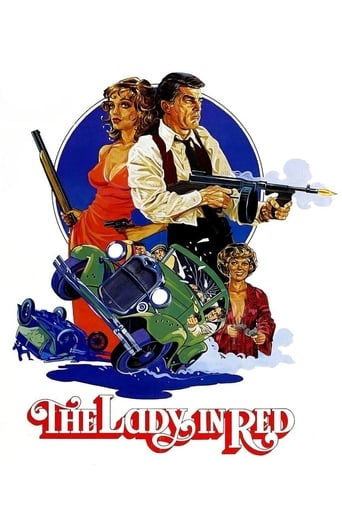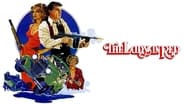calvinnme
This one mainly stands out in my memory because it stars Pamela Sue Martin of Dynasty fame in the title role in a trashy delight. I'm writing this from my 25-30 year old memories of this film's appearance on HBO, so forgive any errors on specifics. Polly Franklin (The lady in red) is a rather naive rural Depression era girl when the film opens who is a victim of one set of harsh circumstances after another. She gets kidnapped by gang of bank robbers, beaten and thrown out by her father when she gets home late that night as a result because he assumes she could only be late because she was sleeping with some guy, arrested when - homeless and hungry - she has to resort to supporting herself via the world's oldest profession and her first john turns out to be a cop, meets up with the world's meanest and most corrupt prison guard while in jail, and on and on it goes. Ultimately, she ends up as Dillinger's girl - the famous "lady in red". The big coincidence here - Dillinger was the bank robber whose gang kidnapped her and started her life on its downhill slide in the first place. Of course this film is complete fiction, but ultimately Mr. Dillinger is in for a big shot of Karma for ruining this girl's life, and that wasn't even her aim. That's only fair, since I'm sure he didn't mean to ruin her life when he kidnapped her as a human shield way back on the farm.If you're 50 plus and remember when HBO, independent studios, and even the big studios used to make all kinds of small trashy treasures such as this, smile and say "cheese", I think you'll like it. I will warn you there are some very violent scenes, though, and I'm not just talking about machine guns. I'll put it this way - you'll probably never look at big electric salon-style hairdryers the same again after you see this movie.
Igenlode Wordsmith
This picture makes for an interesting companion piece to Michael Mann's recent "Public Enemies"; it covers not only the same era and the same setting but, inevitably, much of the same source material. And compared to earlier black-and-white gangster movies it shares a similar distinctly modern sensibility. Indeed, dubbed a "cheerful exploitation flick", it far outdoes the more recent film in the sheer quantity of sex and nudity on display. Yet oddly enough it manages to avoid the impression of gratuitous indulgence: the lolling female flesh on view is treated as more matter-of-fact (sometimes grotesque) than erotic, and the explicit violence is never casually treated."The Lady in Red" turns out to succeed on a number of levels where "Public Enemies" failed: above all and most vitally in characterization and plot development. We actually care what becomes of the heroine and those she meets, however lurid the scenarios that ensue. Individuals are vividly drawn and memorable, and a vein of black humour periodically enlivens the script; it even conjures up some moments of almost lyrical happiness to provide a far more convincing love affair than Mann can achieve. Every victory over tyranny may seem to leave Polly in the long term worse off, and yet we cheer fiercely at her rebellion. There is no lack of audience identification here.The film is also surprisingly sure-footed in its period setting. After the initial reflex jolt at seeing the familiar monochrome settings re-enacted in colour -- unthinking: of course in reality the colour would always have been there, it's just that we never saw it -- "Lady in Red" pulls off the rare trick of presenting a world that seems entirely natural to its era. The cars are not conscious museum pieces, the clothes are not being worn as costumes, the props are not just set dressing: 'period' productions so often give the air of having tried too hard over every glossy detail, or else of importing a patronising grime of deprivation. This one seems to do neither. It even gets away with the potentially heavy-handed use of period cultural references (Elliot Ness, King Kong). After a while -- the ultimate accolade -- you forget that it's in colour.And finally, despite an escalating violence/body count, this film manages to retain death to genuinely shocking effect. There are no diminishing-return shots of gun porn here; no five-minute jerking, numbing sprays of muzzle-flash after dark. (And, although it had not until now occurred to me, no cars that roll over and burst into flames...) A lot of people wind up dead one way or another: but seen through Polly's eyes, it is neither cheap entertainment nor taken for granted.Acting performances are admirable all round in both major and minor roles. The use of music, in particular the evocative "42nd Street" as general theme to the picture in changing moods for each context, is excellently done. This isn't the sort of picture I would have anticipated liking -- the breast count alone is about fifty times greater than anything I'd normally see -- but I found it quite unexpectedly successful... and, I'm afraid, superior on every level to "Public Enemies", with which it has on the surface so much 'modernity' in common.
rlcsljo
If they had called it "The life of a Gun Moll", nobody probably would have gone to see it. So they went with the Dillinger angle, but forget it this is Pamela Sue's film.If you ever wondered how "good little" girls end up being window dressing for some of the most notorious gangsters that ever lived, this film gives a good look at her rebellion against her strict religious up bringing and her descent into crime and prostitution.Pamela Sue is so cute, you have a hard time believing she is a hardened criminal, but she just about pulls it off.
Guy_T
Clearly a product of the Corman School, Sayles's first major screenplay shows that he already knew how to tell a great story from an interesting angle, something he has never forgotten how to do.Director Teague keeps the pace rattling along, and hammers the message home fast (he was an occasional assistant to Sam Fuller, of course).The plot's quite straightforward, and all the better so - this packs something of the punch of the 30's classic gangster films, but with distinctly 70's sensibilities to violence.Where the film becomes more interesting than your average low-budget 'gangster-exploiter', however, is in the telling of the story through her eyes, rather than his (a distinctly 70's approach). Yet it's wonderfully ambiguous, on reflection, as to whether the film champions her willingness to break away and start acting for herself (she's a great strong character), or whether she just goes from one woman in peril situation to the other (which is the plot, basically).I've probably over-analyzed it already, but if you've got a spare hour and a half on your hands, give it a chance. A classic of its kind.





